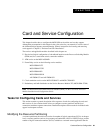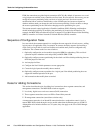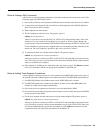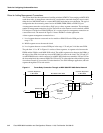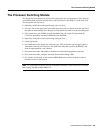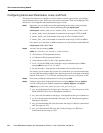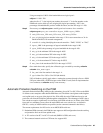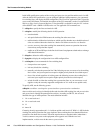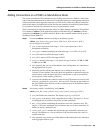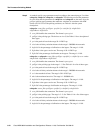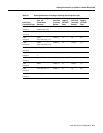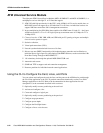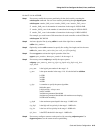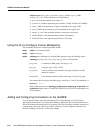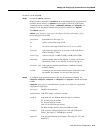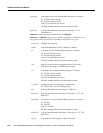
Card and Service Configuration 6-9
Adding Connections on a PXM in a Stand-Alone Node
Adding Connections on a PXM in a Stand-Alone Node
This section describes the CLI commands for provisioning connections on a PXM in a stand-alone
node. Connection addition abides by the rules for a standard connection or a management connection
in the form of either a three-segment connection or a DAX con. See “Rules for Adding Connections”
earlier in this chapter. In addition this section describes the commands for modifying certain features
for a connection and policing connections by way of usage parameter control.
The CLI commands correspond to functions in the Cisco WAN Manager application. The preferred
CLI command is addcon. (If the application requires NSAP addressing, use addchan to add the
connection and cnfchan if you need to modify it. Refer to the command reference for the syntax.)
In addition, On the PXM CLI:
Step 1 Execute the addcon command according to the following syntax:
addcon <port_num> <conn_type> <local_VPI> <local_VCI> <service> [CAC]
[mastership] [remoteConnId]
• port_no is the logical port in the range 1–32 for a user connection or 34 for
management connection.
• conn_type is a number identifying the connection type—1 for VPC or 2 for VCC.
• local_VPI is the local VPI in the range 0–4095.
• local_VCI is the local VCI in the range 0–65535.
• service is a number in the range 1–4 to specify the type of service: 1=CBR, 2=VBR,
3=ABR, and 4=UBR.
• CAC optionally lets you turn off the addition of the loading affect of a connection to
the aggregated load on a port.
• mastership specifies whether the endpoint you are adding is the master or slave.
1=master. 2=slave (default). The syntax shows this parameter as optional because you
need to enter it at only the master end. Slave is the default, so you do not explicitly
need to specify it when entering a DAX con.
• remoteConnId identifies the connection at the slave end. The format for remoteConnId
is Remote_nodename.slot_num.remote_VPI.remoteVCI. Note that the slot number of
the active PXM is always 0 when you add a connection because the PXM slot number
is a fixed, logical value.
Step 2 If necessary, modify a connection by using cnfcon:
cnfcon <conn_ID> <route_priority> <max_cost> <restrict_trunk_type> [CAC]
• conn_ID identifies the connection. The format is logical_port.VPI.VCI.
• route_priority is the priority of the connection for re-routing. The range is 1–15 and
is meaningful only in relation to the priority of other connections.
• max_cost is a number establishing the maximum cost of the connection route. The
range is 1–255 and is meaningful only in relation to the cost of other connections for
which you specify a maximum cost.
• restrict_trunk_type is a number that specifies the type of trunk this connection can
traverse. The numbers are 1 for no restriction, 2 for terrestrial trunk only, and 3 for
satellite trunk only.
• CAC optionally lets you turn on or off the addition of the loading affect of a connection
to the aggregated load on a port.



